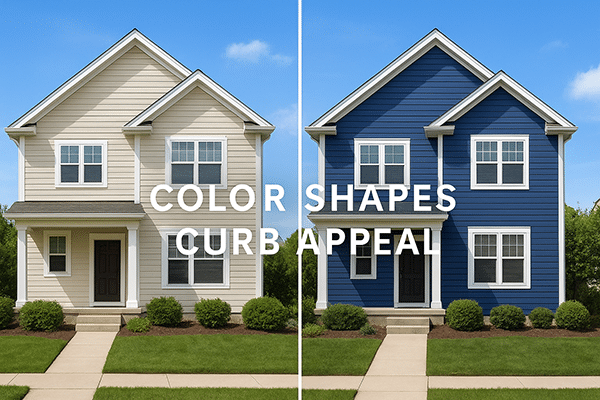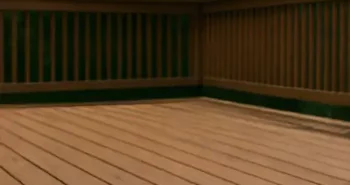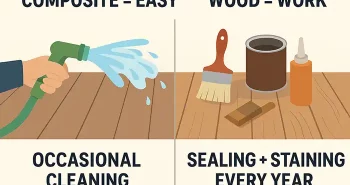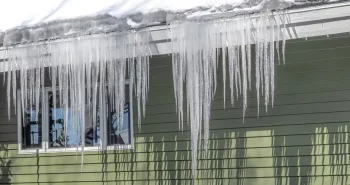Quick Overview: Choosing the Right Siding Color for Your Home
Selecting the right siding color shapes curb appeal, affects perceived home size, and even influences energy efficiency. With a few design principles, you can pick a color that enhances your architecture and fits your surroundings. Below are the key factors to guide your choice.
- Architectural Fit: Choose colors that match your home’s style — timeless neutrals for Colonials, earthy tones for Craftsman designs, bold contrasts for Modern homes, and layered palettes for Victorian details.
- Cohesive Exterior Elements: Coordinate siding with fixed features like roofing, trim, shutters, and accent colors to avoid clashing undertones or mismatched pairings.
- Environmental & Neighborhood Context: Consider landscape, regional style, coastal influences, and any HOA restrictions when deciding whether to blend in or stand out.
- Lighting & Daily Color Changes: Test samples at different times of day, as sunlight, orientation, and seasonal lighting can drastically shift how siding colors appear.
These simple guidelines help you choose a siding color that looks great today and stays visually appealing for years to come.
Not sure which siding color is right for your home? Here, we’ll go over a few of the most popular residential siding colors along with some tips to help you choose an option with confidence.
In this article, you’ll learn:
✓ Why siding color matters for curb appeal, property value, and energy efficiency.
✓ How to choose colors that complement your home’s architectural style, from Colonial to Contemporary.
✓ The importance of coordinating your siding with the roof, trim, and accent colors for a cohesive look.
✓ How to factor in your home’s surroundings, such as landscape, neighborhood, or coastal environment.
✓ Why lighting and orientation can change how colors appear throughout the day.
✓ The role of color psychology in creating the right visual tone for your home.
✓ How to balance timelessness and trends when selecting siding shades.
✓ Common coloring mistakes to avoid, like skipping samples or choosing clashing tones.
✓ What to know about maintenance and longevity when selecting darker or lighter hues.
Does Siding Color Matter on a House?
Choosing the perfect siding color might not seem like a big deal, but it’s definitely something worth putting some thought into. Your home’s siding color does more than enhance appearance; it sets the tone for your entire property. A well-chosen color scheme can dramatically increase overall curb appeal, which can have a direct impact on property value and speed of sale. The color may even affect the perception of size and shape of your home, while providing a visual balance with the surrounding landscape. Depending on where you live, siding color can even improve energy efficiency. For example, light colors reflect UV rays and help keep homes cooler during warmer months, while dark colors absorb heat and add warmth in cooler areas.
Tips to Help You Choose the Right Siding Color for Your Home
The psychological impact of color on home perception is real, and with a few simple tricks, it’s easy to find the perfect exterior color scheme for your property. Here are a few tips to help you through the process of choosing colors that will complement your architecture and overall aesthetic vision.
Consider Your Home’s Architectural Style
Every home style has its own character, and the siding color you choose should highlight its best features. This is why the architecture of your home should serve as the foundation for your color palette. To make your home look its best, consider some of the following recommendations for colors that help highlight architectural features.
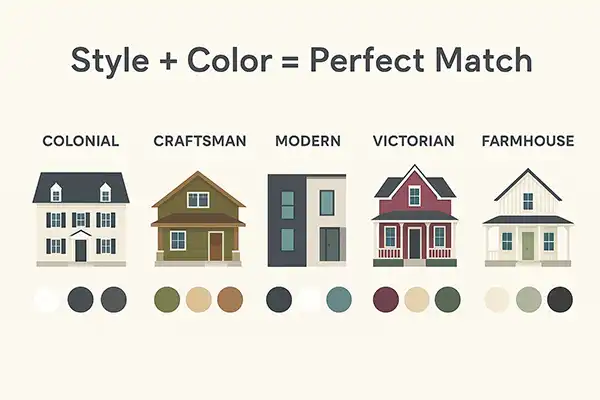
Colonial Homes: Prioritize timeless, symmetrical hues such as white, navy, or slate gray. These shades preserve the home’s traditional aesthetic. If you’d like, add a pop of bright color to the shutters.
Craftsman Homes: Earthy colors like olive green, tan, rust, and sage pair beautifully with wood or stone accents.
Modern or Contemporary Homes: Dark tones like charcoal, black, or deep blue create a sleek contrast with light trims and minimalist lines.
Victorian Homes: Embrace bold, layered colors such as burgundy, mustard, and forest green to highlight intricate details and trim work.
Ranch or Farmhouse Homes: Exterior paint colors like rustic red or earthy green are great options that pair well with offwhite trim coloring.
When in doubt, look to your home’s architectural roots for color inspiration. Matching the design era with complementary colors helps maintain authenticity while enhancing visual appeal.
Look at Your Roof, Trim, and Accent Colors
Siding and trim often go hand-in-hand, so it’s essential to make sure the colors appear cohesive and harmonized rather than awkwardly paired. The same mentality should be applied to residential roofing, shutters, doors, and even your driveway to help boost curb appeal.
To create the perfect color combination, start with fixed elements like your roof, as this is likely the hardest (and most expensive) thing to alter. Then, choose complementary undertones, as warm and cool combinations tend to clash. For example, a brown roof goes great with beige, cream, or even a forest green vinyl siding. If you want to add some contrast, do so with the trim. Crisp white or dark colors go well with several different color options.
Factor in Your Home’s Surroundings
The natural surroundings of your home’s exterior should also play a role in your color selection. Do you want to blend into the natural environment, or are you trying to make a statement? If you want a more cohesive look, choose colors that blend with the surrounding landscape. If you want your home to stand out, opt for a unique combination with high contrast. For example:
Natural Landscapes: Earthy tones like greens, browns, and taupes complement wooded or rural settings.
Coastal Areas: Crisp white trim paired with soft blues or light grays gives a clean, modern aesthetic that blends with the sea.
Just remember, if you live in a neighborhood with an HOA, you may be restricted to the number of colors to choose from.
Think About Lighting and Orientation
Different lighting elements also play a significant role in how your siding paint will look throughout the day. The same shade can look completely different depending on the time of day, the direction your home faces, and even the season.
Natural Light Exposure: Homes that face south receive more sunlight, which can make colors appear lighter and warmer. North-facing homes, on the other hand, may cause colors to look cooler or slightly muted.
Time of Day: View your color samples in the morning, afternoon, and evening to see how the tone shifts under changing light conditions.
To get a better idea of how colors can change with the elements, consider bringing home a few physical samples and painting a small test patch of each to test them out.
Utilize the Basics of Color Psychology
The psychology of color can be powerful, and there are many emotions and impressions tied to each color family. While this shouldn’t necessarily be the primary reason for your choice, it’s an interesting factor to consider. Some of the ways that different colors can impact your viewpoint and mood include the following:
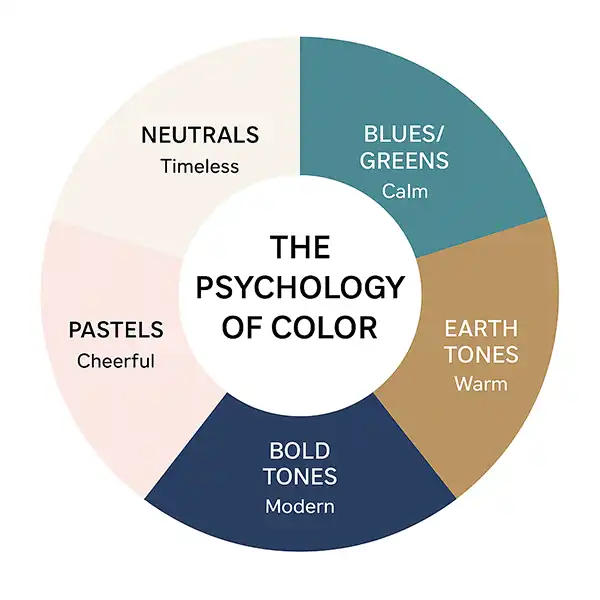
Classic Neutrals (White, Gray, Beige, Taupe): Timeless, clean, and versatile. These shades convey balance, sophistication, and simplicity.
Blues and Greens: Calm, peaceful, and inviting. These hues work beautifully for coastal homes or anyone seeking a relaxed, natural vibe.
Earth Tones (Tan, Brown, Olive, Rust): Warm and grounded, these colors connect your home to nature and feel especially fitting in wooded or rural areas.
Bold Tones (black, Navy, Deep Red): Strong and contemporary. They make quite the visually appealing statement and are ideal for modern or minimalist architecture.
Pastels and Light Tones: Airy, fresh, and cheerful; great for small homes, cottages, or bright coastal properties.
Balance Trends with Timelessness
Finally, while it can be tempting to follow the latest design trends, changing the color of your siding can be costly. Therefore, it’s best to choose an option that’s both timeless and trendy; something that feels modern, but won’t be outdated in five years. You can never go wrong with the classic look of neutrals, so start by exploring some grays, beiges, and soft white colors. There are plenty of options in both light and dark shades to help you play around with aesthetics and overall feel.
It’s also important to consider your long-term plans. If you anticipate moving in the next few years, choosing an option that’s more traditional and buyer-friendly is recommended. For those who plan to stay and want something a bit more eccentric, talk to a siding professional for some recommendations. Just make sure that you double-check any HOA requirements to avoid costly mistakes.
Common Coloring Mistakes to Avoid
Even with the best intentions, many homeowners make simple color mistakes that can throw off their home’s exterior design. Some of the most common errors throughout the process include things like:
✗ Ignoring the roof and trim colors
✗ Using too many contrasting colors
✗ Choosing a color that’s too bright or too dark
✗ Skipping the sample test
✗ Forcing complex color combinations on traditional home designs (sometimes, less really is more)
✗ Not incorporating lighting and environment into the decision
✗ Overlooking the neighborhood aesthetic
✗ Forgetting about long-term maintenance factors
Home Maintenance and Longevity Considerations
Before painting your home’s exterior, it’s also important to consider the maintenance and longevity of the color you want to choose. While dark, bold options can add personality and depth, they also tend to come with a bit more upkeep. Dark colors tend to absorb more sunlight and, therefore, fade faster than lighter alternatives. Classic shades like taupe or light gray are good options if you live in a place with a lot of dust or pollen, as they work well to mask any buildup between siding cleanings. The siding material you choose will also play a role in how well colors hold over time, so talk to an expert siding contractor to better understand your options.
Partner With a Professional or Siding Contractor
If you want to transform your home without having to undergo a huge renovation project, changing the color of your siding is a great option. If you’re ready to transform your home’s exterior but aren’t sure where to start, First Star Exteriors can help. Our team of experienced professionals provides expert guidance on siding materials, color selection, and installation to ensure your home looks stunning and performs beautifully for years to come. Book a free inspection with us today to learn more.

